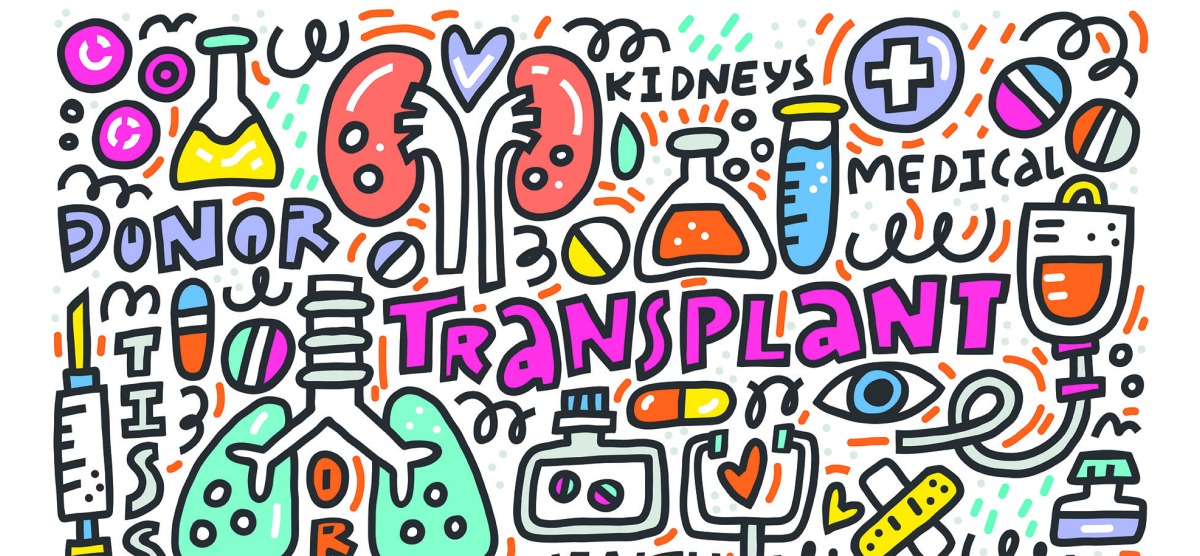
The Patient Will Live
After a transplant, recipient and donor adjust beautifully.
When the living donor coordinator called, I answered the phone from a maze of boxes containing the last eight years of my life, possibly including the cat, whom I hadn’t seen since breakfast. It was the fall of 2015, and my partner had just announced that she had fallen in love with her intern, seemingly unconcerned that said intern was about to get married. We had planned to attend the wedding; I had just purchased a set of cereal bowls off the registry. My friends unanimously agreed that if the universe was at all a fair place, the Other Woman’s Cheerios would be soggy every day for the rest of her life.
A shock like that knocks the air out of your lungs. I was shaken and unsure what to do next. I’d lost the woman I loved, my job was stressful and exhausting, and I was packing to move out of the home in which I’d lived for many years. I had long forgotten about the Facebook post I’d seen the year before, written by a friend who had been on the waiting list for a donor kidney for what seemed like forever, and was running out of time. Why not? I’d thought.
But my rare blood type and his heart condition disqualified us as a match, and I added my name to the National Kidney Registry. Transplant teams prefer living donors because the organs last about twice as long as cadaver donations. And there’s plenty of demand: 100,000 people are currently waiting for a kidney transplant. Thirteen of them die every day.
The coordinator was polite, but urgent. The recipient was 25 years old and would be transplanted at Johns Hopkins. Could I come in on Monday for follow-up testing to be sure I was still healthy? Could I have the surgery in two weeks?
It all happened so fast that I didn’t have time to get frightened until I was on the table, the anesthesiologist’s kindly face hovering above my own. I breathed; I counted backwards; I woke up in recovery with a Band-Aid over my belly button and a head full of tumbleweeds. I spent only a single night in the hospital, with my oldest friend —my summer-camp sweetheart —wedged uncomfortably on a cot next to my bed, wearing an extra hospital gown as pajamas. I was sent home with a bottle of Percocet and, more healing still, a text from the transplant coordinator: “Surgery successful. Kidney adjusting beautifully. Patient will live.”
At an aching moment in my life when very little felt worthwhile or positive, the miracle of this surgery —an organ that could be unplugged from one person and plugged into another, and both of them live—felt like a reprieve, a One Good Thing that could never be taken away, even by a challenging job or a rom-com-worthy relationship blowup. The recipient and I, no longer anonymous to each other, chatted over email. He’s off dialysis and doing well. He wants to go into cybersecurity.
Less than a year later, I married that oldest friend, with whom I started falling in love sometime during that long, sleepless hospital night. We now have two young children, and I have a new, better job. My stalwart right-hand kidney has near-doubled in size to take on the load, and I don’t miss Left Kidney a single bit. I wish I could go back and tell my younger self, sweaty and tear-stained and covered in discarded packing tape, that middle age would be far better than she ever could have imagined. All she had to do was answer the phone.
Liz Scheier ’00 is a product developer living in Washington, D.C. with her husband and two children. She did eventually locate the cat. Interested in becoming a living donor? Contact the National Kidney Registry.
Published on: 05/20/2019